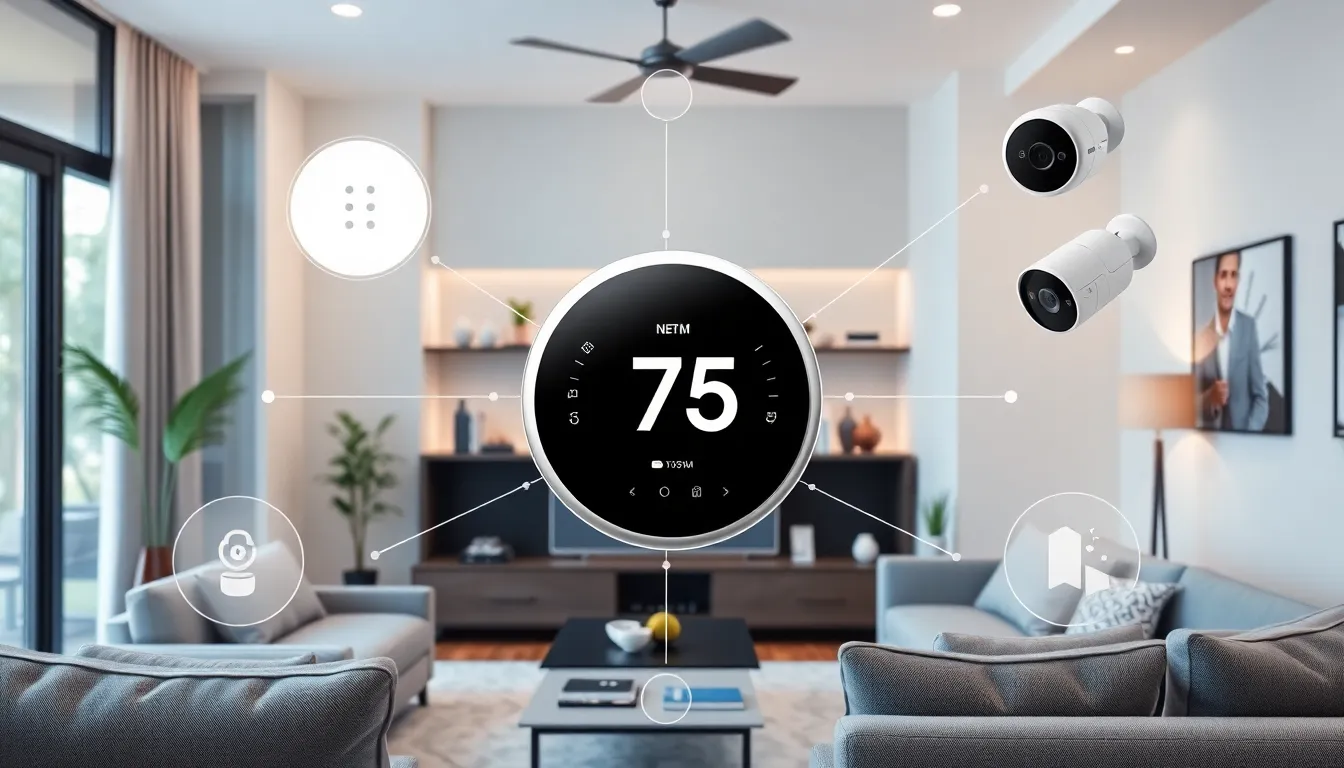Table of Contents
ToggleIn a world where smartphones can practically read minds and refrigerators have better social lives than most of us, high-tech innovations are changing the game. These dazzling advancements aren’t just for tech geeks in lab coats anymore; they’re transforming everyday life in ways that are both mind-blowing and, let’s face it, a little hilarious.
Overview of High Tech Innovations
High-tech innovations significantly impact everyday life. They range from personal devices like smartphones to intelligent appliances that streamline household chores. Each advancement contributes uniquely to enhancing convenience and efficiency.
Smartphones serve as multifunctional tools, integrating communication, entertainment, and productivity. Over 80% of Americans own a smartphone, reflecting the device’s role in modern life (Pew Research Center, 2021). They connect individuals to information and services anytime and anywhere, facilitating quick access to essential functions.
Similarly, smart appliances transform homes into connected environments. Refrigerators that track groceries and washing machines that optimize water and energy use represent just a fraction of the innovations available. Consumers can enjoy greater efficiency and reduce utility bills through these technologies.
Wearable devices also showcase high-tech advancements. Fitness trackers and smartwatches monitor health metrics in real-time. With the global wearables market projected to reach $60 billion by 2023, these gadgets improve health awareness and lifestyle choices (Statista, 2023).
Artificial intelligence drives many high-tech innovations, reshaping industries across the board. Businesses leverage AI for data analysis, customer service, and operational efficiency, leading to smarter decision-making processes. Experts predict that AI could contribute $15.7 trillion to the global economy by 2030 (PricewaterhouseCoopers, 2017).
Overall, high-tech innovations are reshaping how people live and work. Accessibility and increased relevance make these technologies essential tools for navigating modern life. Embracing these advancements enhances daily experiences and offers solutions to previously complex problems.
Key Areas of High Tech Innovations

High-tech innovations significantly influence various sectors, changing how people interact with technology. Notable areas driving innovation include artificial intelligence, Internet of Things, and biotechnology.
Artificial Intelligence
Artificial intelligence reshapes industries across various fields. Businesses utilize AI for data analysis, improving efficiency and enhancing decision-making processes. The technology attracts significant investment, with projections estimating contributions of $15.7 trillion to the global economy by 2030. AI in customer service helps streamline operations, leading to enhanced customer experiences. Algorithms analyze vast data sets, uncovering patterns and trends that organizations might overlook.
Internet of Things
The Internet of Things connects devices in an extensive network, promoting seamless communication. Smart home systems, including security cameras and thermostats, provide homeowners with increased control over their environments. Data exchange between connected devices fosters automation, resulting in improved efficiency and convenience. Experts forecast that the number of connected devices will surpass 30 billion by 2025. This growth presents new opportunities for businesses to leverage data for insights and innovation.
Biotechnology
Biotechnology transforms healthcare and agriculture, applying advanced technology to living organisms. Genetic engineering plays a crucial role in developing crops resistant to pests, improving yield and sustainability. In pharmaceuticals, innovations lead to personalized medicine tailored to individual genetic profiles, enhancing treatment effectiveness. The biotechnology sector is expected to grow steadily, predicted to reach $727 billion by 2025. Advances in CRISPR and other gene-editing technologies provide powerful tools with the potential to address complex health issues.
Impact of High Tech Innovations on Society
High-tech innovations significantly influence society, driving economic growth and enhancing overall quality of life.
Economic Growth
High-tech innovations spur economic growth by creating new industries and enhancing productivity. According to reports, AI alone could contribute $15.7 trillion to the global economy by 2030. Innovations in the IoT are facilitating efficiencies across sectors; predictions estimate over 30 billion connected devices by 2025. Increased automation reduces costs and improves operational performance in businesses. The biotechnology sector, projected to reach $727 billion by 2025, showcases how advancements can lead to new job opportunities and investment. These innovations not only provide immediate benefits but also foster long-term economic resilience.
Improved Quality of Life
High-tech innovations significantly improve quality of life for many individuals. Wearable devices, including fitness trackers and smartwatches, empower users to monitor health metrics and adopt healthier lifestyles. Smart appliances, such as energy-efficient washing machines and advanced refrigerators, simplify household chores while lowering utility bills. Moreover, widespread smartphone adoption, with over 80% of Americans owning one, connects people and offers convenience in daily tasks. This access to technology enhances communication, entertainment, and productivity, making daily experiences richer and more streamlined. Overall, high-tech innovations redefine how individuals engage with their environment, contributing to a more fulfilling life.
Future Trends in High Tech Innovations
The landscape of high-tech innovations continues to evolve rapidly. Artificial intelligence holds a central role in future developments. By enhancing decision-making processes and personalizing customer experiences, it significantly impacts various sectors.
Connected devices through the Internet of Things (IoT) will become increasingly prevalent. Predictions indicate over 30 billion connected devices will exist by 2025. This connectivity facilitates seamless interaction among devices, automating daily tasks for users.
Biotechnology is set to revolutionize healthcare and agriculture. Advances in genetic engineering promise to create more effective treatments and sustainable agricultural practices. The biotechnology sector is projected to grow to $727 billion by 2025.
Wearable technology will see continuous growth, expanding its capabilities. As health monitoring gains prominence, the global wearables market might reach $60 billion by 2023. Wearable devices not only track fitness metrics but also enhance overall well-being.
Smart appliances will further improve household efficiency. Innovations in this area aim to simplify everyday tasks, saving time and reducing energy costs. Energy-efficient refrigerators that monitor grocery levels exemplify this trend.
Sustainability will be a key focus for future tech innovations. Developers will emphasize eco-friendly products that minimize environmental impact. Expect to see more energy-efficient technologies that support green living.
Urban areas will increasingly integrate smart city technologies. These innovations bolster infrastructure through enhanced connectivity and improved public services. Such advancements aim to create more livable and efficient urban environments.
High-tech innovations are set to shape the future, redefining personal and societal engagement. As these trends develop, they promise to enhance daily experiences and contribute to economic growth.
Challenges Facing High Tech Innovations
High-tech innovations face several significant challenges that can hinder their development and implementation. One major issue involves security risks. As technology advances, so does the potential for cyberattacks. Businesses must continuously invest in robust security measures to protect sensitive data and maintain user trust.
Regulatory hurdles also create obstacles for high-tech advancements. Governments often struggle to keep pace with rapid technological changes, resulting in outdated regulations. These discrepancies can limit innovation and deter companies from exploring new ideas.
Another challenge pertains to the digital divide. Not everyone has equal access to high-tech innovations, especially in underprivileged regions. Wealth disparity limits the ability of some communities to benefit from advancements, creating inequity in technological progress.
Sustainability issues present additional concerns. Many high-tech innovations rely on materials and processes that harm the environment. Companies must prioritize eco-friendly alternatives to reduce their carbon footprint and align with consumer demands for sustainable practices.
Adoption rates can also prove challenging. While high-tech innovations offer significant advantages, some individuals and organizations resist change. Familiarity with traditional methods can slow down the acceptance of new technologies, impacting overall progress in the sector.
Funding and investment pose challenges for startups and smaller companies. Securing financial backing often proves difficult, hindering their ability to bring innovative ideas to market. Without sufficient resources, even the most promising technologies may struggle to reach their full potential.
Overall, addressing these challenges is crucial for the continued evolution of high-tech innovations and their ability to enhance daily lives.
High-tech innovations are undeniably changing the landscape of everyday life. As these advancements become more accessible, they offer unprecedented convenience and efficiency, impacting how individuals interact with their environment. From smart appliances to wearable technology, these tools enhance productivity and promote healthier lifestyles.
The future holds even more promise with the continued integration of artificial intelligence and the Internet of Things. As society navigates the challenges that accompany these innovations, addressing security and accessibility will be crucial. Embracing these technologies not only enriches daily experiences but also fosters economic growth and sustainability. The journey of high-tech innovations is just beginning, and its potential is boundless.







